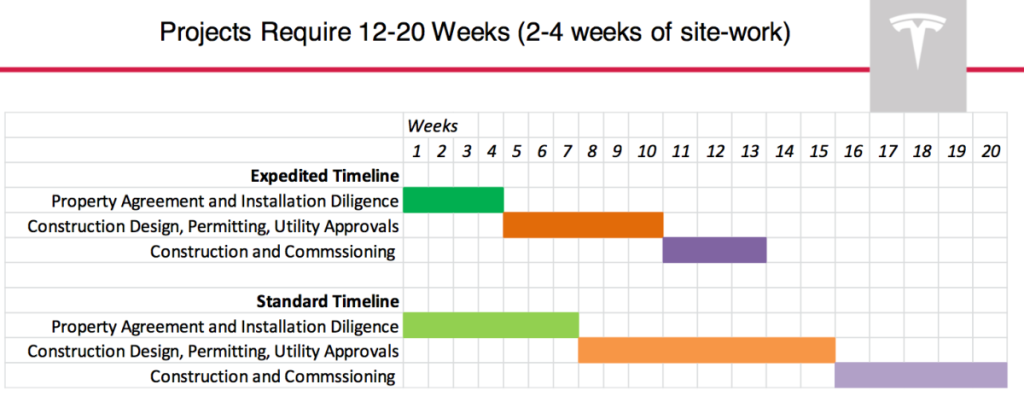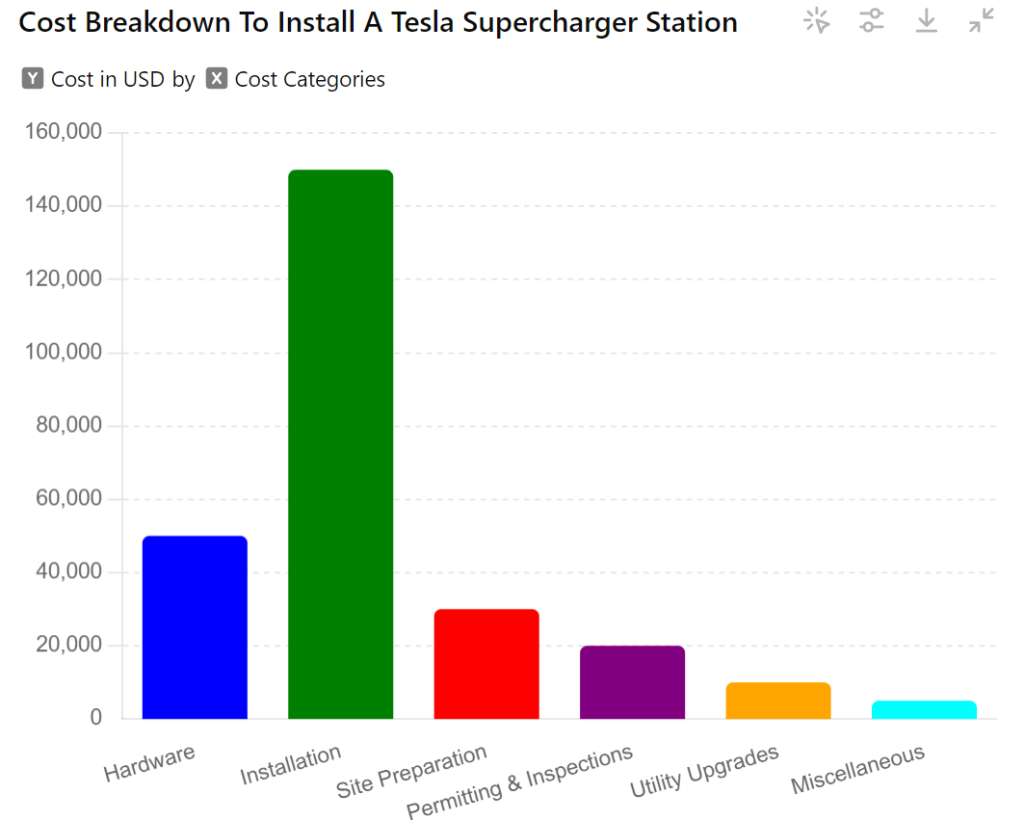
There is good news for all who are thinking to start Tesla charging station. Tesla is building a nationwide network of Supercharger stations in the U.S. There is huge opportunity for all the business seekers.
Are you seeking to install a Tesla-like Supercharger Station? Look no further. This article will tell you the cost of Tesla supercharger installation and go over the other basic details, including the features and benefits of EVs.
Tesla is a famous global electric vehicle (EV) manufacturer. Its advanced battery technology, such as the use of lithium-ion cells, enables a more extended range and faster charging capabilities. For example, the Model “S” Plaid boasts a range of over 520 miles, setting new standards for electric vehicle range. Tesla is best known for its innovations in the automotive industry. They make electric vehicles an eco-friendly option, whether in terms of design, performance, or high-tech features like autopilot systems for semi-autonomous driving.

Tesla’s Contribution to the Electric Vehicle Revolution
Reports indicate that to meet the US’s goal of having a majority of powered vehicles by 2030, a staggering 1.2 million public EV charging stations and 28 million private chargers will be needed. This underscores the urgent need to integrate electric vehicles into our daily commutes, a crucial step towards promoting sustainable transportation. Let’s dive into this journey and understand what makes Tesla unique.
What Makes Tesla Supercharger A Benchmark in the EV Industry?
There are three charging capabilities that are uncreatively dubbed L1, L2, and L3, where “L” represents the Level. The charging speed of Level 1 is the lowest, and the charging speed of Level 3 is superfast, while the speed of charging Level 2 is average. The basic difference between these three levels is the charging delivery that they provide at different speeds. Let us deeply understand it:
Level 1 (L1) Charging
Level 1 charging is the most basic type of charging that utilizes a standard 120-volt AC household. The vehicle’s charging speed is slow and usually covers 2-5 miles of range per hour of charging. It takes about 40 to 50 hours to fully charge an electric vehicle.
Level 2 (L2) Charging
Level 2 charging is a faster method that utilizes a 240-volt AC power source. It typically provides 10 to 50 miles of range per hour of charging, making it suitable for work, home, and public charging for all types of EVs. It takes approximately 4 to 10 hours to charge a battery electric vehicle completely.
Level 3 (L3) Charging
This is the superfast charging method currently available. It is also known as DC fast charging, where DC stands for Direct Current. As it provides the DC method for charging, it charges more quickly than the AC method. It provides a 100-mile range per hour of charging. It is the fastest charging available in the EV market. This type of charger takes approximately 60 to 90 minutes to charge an electric vehicle.
What is the Development Process of an EV Charging System like the Tesla Supercharger?
The deep-seated process is followed for the development of EV charging systems like Tesla supercharges. This complex process involves various stages, from thought to deployment. Here is a further explanation of the development process of an EV charging system.
Planning and Conceptualization of EV Charging System
In this step, developers define the objectives and goals behind the development of the EV charging System. The developer aims to determine the target audience, features, and designs by determining the specific features and functionalities required in the fast-charging software.
Understand System Architecture
After this step, the system architecture includes client-side and server-side components, database, and communication protocols while developing a robust security framework to protect user data and financial transactions.
Designing User Interface
The system must be designed to scale and accommodate further growth in the number of users and charging stations.
Database Structure Development
The intrinsic development of the database structure for the Tesla Supercharger helps store user profiles, charging station information, and transaction history.
Mobile Application and Web Development
Developing a mobile or web application helps ensure wider accessibility of EV charging systems among users. Important features like user reviews, push notifications, user registration, profile management, and login must be integrated to improve user satisfaction.
Payment Integration
Design the payment gateways to pay online for the charging session credit options such as mobile wallets, Debit/Credit cards, and subscription models to facilitate secure and convenient payments.
Security and Data Privacy
Integrating authentication and authorization helps ensure data security while using the EV charging system. It also secures user data and stores financial information to safeguard user privacy.
Testing and Quality Assurance
This step includes monitoring performance, functionality, security, and usability in order to address and resolve any identified bugs and issues.
Scalability and Expansion
A plan should be made for the software system’s scalability and expansion as the number of users and charging stations grow.
Hardware of EV Fast Charging System Like Tesla Supercharger
Developing an EV fast charging system like the Tesla Supercharger include various key components and steps. Here is the process one should follow to develop the hardware for such a system.
Design the Charging Station
This charging station includes various components such as a Power Module, Cooling system, charging connector, etc.
- Power Module
Its reponsibility is to convert the AC power from the grid in the DC (Direct Current) power, which is used for fast charging of EVs. The power module’s consider enery efficient and the capability to gives a huge range of power outputs.
- Cooling System
The design should include a cooling system, potentially using liquid cooling similar to the Tesla supercharger.
- Charging connector
High power interfaces with the EV to provide power. This part of the design will need to consider the various types of connectors used by different EV manufacturers.
Develop a Power Management System
It should be designed to efficiently and safely transfer a large amount of efficiency. This part of the design will also need to consider the various types of connectors used by different EV manufacturers.
Communication Capabilities
It needs to communicate with a central billing and usage tracking system, which is facilitated by using an EV intelligent energy management system.
Safety and Compliance
Electric vehicle charging infrastructure needs to comply with local laws and other applicable regulations to ensure its safety and reliability.
Cost Of Tesla Supercharger Installation
Cost Breakdown to Install a Tesla Supercharger Station
- Hardware: $50,000
- Installation: $150,000
- Site Preparation: $30,000
- Permitting & Inspections: $20,000
- Utility Upgrades: $10,000
- Miscellaneous: $5,000

Cost Breakdown of EV Fast Charging System
| Cost Element | Average Cost |
|---|---|
| Hardware and Installation | $10,000 to $60,000 |
| Power Supply and Grid Upgrades | $15,000 to $90,000 |
| Software Development | $25,000 to $1,50,000 |
| Total Cost | $50,000 to $3,00,000 |
The cost of Tesla supercharger installation would be around $43,000 per charger and can range up to $200,000, depending on several components that can affect the final budget. On average , it can cost anywhere from $ 100,000 to $ 200,000 per station
When identifying the Tesla supercharger installation cost, it is also essential to understand the advanced features that are integrated into the charging system, which will eventually impact it. Let’s have a look:
Power Supply and Grid Upgrades
It involves the installation of new transformers, cabling and wiring, or even a new substation, all of which add to the total costs.
Software and Networking
This section includes user, Identification, billing, remote monitorinng, and other intelligent functionalities. Besides this, it includes integrating these systems into existing power management infrastructure.
Hardware and Installation
This includes the purchase and installation of the charging station. DC fast charging may cost high due to its high power capacity (up to 250 kW). This factor includes the charger unit, construction, electrical services, and other overhead costs.
Maintenance and Operation
This includes regular repairs, component replacement, inspections, and cleaning. Operational costs also include electricity and customer service.
Here is the average Tesla supercharger installation cost breakdown:
| Cost Factors | Approx Cost in USD |
| Power Supply and Grid upgrades | $18,000 to $120,000 |
| Software Development | $29,000 to $210000 |
| Hardware and Installation | $15,000 to $50,000 |
| Maintenance and Operation | $10,000 to $60,000 |
This is a rough calculation and may not provide the exact cost for an exact project. EV charging infrastructure is speedily evolving, and the cost of Tesla supercharger installation can vary depending on various factors like geography, regulations, and technology development. Not only this, there are many other factors that affect the cost of Tesla supercharger installation. Let’s explore the factors that affect tesla supercharger installation cost.
Tesla Supercharger Installation Cost As Per Company Size
Company size is an essential factor that affects the cost of Tesla supercharger installation. Generally, there are three types of company sizes: Small-sized company, Mid-sized company, and Large-sized company. Here is the breakdown of the Tesla supercharger installation cost.
| Company Size | Manpower | Approx Cost |
| Small-Size Company | 50-200 | $20,000 to $ 45,000 |
| Mid-Sized Company | 200-500 | $50,000 to $1,00,000 |
| Large-Sized Company | 1000+ | $100,000 to $1,500,000 |
Cost Of Tesla Supercharger Installation As Per Location
Location one of the major factor that affects the Tesla supercharger installation cost. The cost varies from location to location, i.e. the developer of the USA may charge more in comparison to India.
| Company Location | Approx hourly rates |
| India | $20 to $40 |
| United States (USA) | $100 to $150 |
| Canada | $100 to $150 |
| United Kingdon | $80 – $120 |
| Germany | $70 – $100 |
| France | $70 – $150 |
| Australia | $90 – $110 |
Tesla Supercharger Home Installation Cost
A Tesla supercharger home installation costs $500 and can add upto 44 miles per hour (70 km per hour) to the car’s driving range, but that will again depend on the electricity panel, wiring, and model. tesla supercharger home installation cost likely comes at $1000 to $7000. That includes the Tesla supercharger home installation cost of upto $500 and another $500 to $600 in installation costs, depending on the home’s existing power capacity and wiring.
Benefits of Tesla Supercharger Stations
Tesla super charger stations have multiple benefits. They not only increase access to EV charging stations but also provide users with a viable option of choosing a more sustainable form of transportation.
Fast Charging Speed
The convenient method, which also increases Tesla supercharging prices, makes long-distance travel more feasible and reduces the charging time compared to the traditional method.
Reliability and Charging Available
It maintains and expands the supercharger network to provide a convenient charging option for its electric cars.
High-Quality Infrastructure
The station’s infrastructure, which is also included in the estimation of Tesla supercharger price, is made to with stand different weather conditions and heavy usage, ensuring reliability and durability over time.
Seamless User Experience
The charging process at the EV charging stations has been straightforward and intuitive, with easy-to-use connectors and clear instructions to increase accessibility.
Strategic Locations for Seamless Services
The charging stations are located on major highways and travel routes, facilitating car owners with easy access to charging infrastructure.
The Final Thoughts
Tesla is best known for its innovations in the automotive industry. Tesla, an electric vehicle (EV) manufacturer, is revolutionizing the industry with its futuristic technology and commitment to promoting sustainable forms of transportation. The Tesla supercharger installation cost is affected by various factors. After reading this article, one will thoroughly understand the estimated cost of Tesla supercharger installation and how the factors can influence it.
Frequent ask questions
Most are not free but are designed to sell fuel like a gas station. This includes the Tesla supercharging network, which automatically bills cars via the credit card associated with each owner’s app.
After plugging in, one can manually increase the charge limit by using the vehicle touchscreen or the Tesla app. Note: Charging speeds slow as the battery charges, so reaching 100% charge will typically take significantly longer than reaching 80%.
Since charging above 80 percent is rarely necessary, stops are typically short and convenient. In Just 15 minutes, superchargers can add upto 200 miles of range.
With simple hand tools, numerous pro charger systems may be installed in 8 to 10 hours. All pro charger lane supercharger systems are arranged to the highest quality standards without cutting the body panels or altering stock hardware.
The Battery performs best when charged regularly. If you allow the battery to discharge at 0%, It may damage the other components and may need replacement. (For example, Low-volt Battery)

